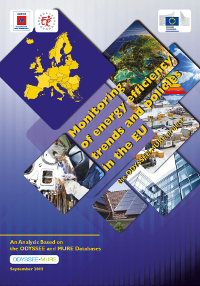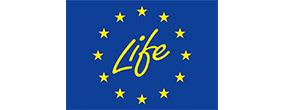Summary
This brochure analyses energy efficiency in each end-use sector in the EU (industry, transport and buildings). The analysis includes both a review of energy efficiency trends and of the policy instruments currently implemented to improve energy efficiency, based on the ODYSSEE and MURE databases. This should help policy makers and other parties involved in energy efficiency and CO2 emission reduction to adapt current policies and to define new, effective policy measures.
Although the main focus is on the improvement of energy efficiency, other drivers affecting the energy demand trend - such as industrial growth, structural changes, lifestyle changes, energy prices - are also considered.
This brochure summarizes three sectoral brochures available on the ODYSSEE-MURE website that provides more in depth analysis of energy efficiency trends and policies on buildings, transport and industry.
Key Messages – Overall Energy Efficiency Trends and Policies
Energy efficiency trends
- Energy efficiency improved by 15% at EU level between 2000 and 2013 (1.2%/year). There has been a net slowdown in the energy efficiency progress since the economic crisis: 1%/year since 2007, compared to 1.3%/year between 2000 and 2007.
- The household sector has achieved the largest energy efficiency improvement, with a regular energy efficiency gain (1.7 %/year). Gains for industry have been divided by a factor 2 since 2007. In transport, energy efficiency progress was in line with the average (1.2%/year) and was more rapid for cars than for transport of goods that was severely hit by the economic crisis.
- In 2012, the final energy consumption was 30 Mtoe lower than in 2000. This situation is the result of two main balancing effects: growth in the economic activity would have led to an increase of 100 Mtoe while energy savings contributed a reduction in final consumption by 180 Mtoe; other factors explaining the rest of the variation, such as demography, changes in lifestyle, modal shift in transport and structural changes in industry. The European targets as specified in the Energy Efficiency Directive EED are 1483 Mtoe primary energy (excluding non-energy uses) and 1086 Mtoe final energy to be reached in 2020. Data from the Odyssee database show that by 2013 primary energy for the EU28 was at 1567 Mtoe and final energy at around 1100 Mtoe that is, already relatively close to the targets.
- Without energy savings, final energy consumption would have been around 180 Mtoe higher in 2012 compared to 2000. Around 33% of the savings come from households, 32% from industry, 27 % from transport and 8% from tertiary.
- Differences between countries are still large in various aspects notably with respect to annual energy efficiency improvements which for the period 2000-2012 reach from 0.6% annual improvement to 3.3%.
Energy efficiency policies
- Across the countries and within a sector there are considerably variations in the approaches to energy efficiency policy. The reason for this observation may be that due to cultural differences and societal habits, measures have different effectiveness according to the country context. It raises, however, also the question whether the national set of measures can be extended to include other measure types which have not been experienced in the past.
- All in all, though there is some dynamics in the mix of measure types, the sectoral focus remains relatively stable. Fiscal measures astonishingly play a little role in the measure mix, except for the transport sector though the process of the National Energy Efficiency Action Plans (NEEAPs) seem to improve on this.
- The recent economic and financial crisis, from 2008 to2012, had a profound effect on the policy making with Europe, especially in countries more strongly hit by the crisis. Financial programmes have generally been reduced in those countries while in some occasions financial subsidies for energy efficiency were used to stabilise the economy. This approach could have been more largely used to encounter the economic crisis, given that energy efficiency measures tend to support the local economy.
- The influence of the EU energy efficiency policy was already quite important; it became even more important, considering which measures have been proposed under the National Energy Efficiency Action Plans NEEAPs and the Art. 7 of the Energy Efficiency Directive EED at national level.
- Energy Saving Obligations have become an important instrument which many countries have introduced or are in the process of introduction due to the Energy Efficiency Directive: 16 countries have reported to rely on energy efficiency obligation schemes, generally combined with additional policy measures. The other countries will only use other policy measures as authorised by the Directive, the so called “alternative policies”.
- The process of the National Energy Efficiency Action Plans NEEAPs was a large success with respect to evaluation practices spreading the use of quantitative evaluation methods across the Member States.
- Specific tools have been developed under the MURE database to define and identify successful energy efficiency policies, to structure and analyse interacting policies and to analyse selected policy fields such as behavioural policies.
- Scoring energy efficiency policies and trends aims to provide comparison indicators and comparable characteristics which help countries to understand whether their policies are comparable or better than in other countries or whether they can learn from other countries to improve their policies. For that purpose, scoreboards that have been developed both for indicators and policies within the Odyssee-Mure project, are useful instruments which gather in general multiple aspects which are, as far as possible, quantitatively evaluated and compared among countries.




